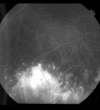Necrotising retinopathies simulating acute retinal necrosis syndrome
- PMID: 15615755
- PMCID: PMC1772458
- DOI: 10.1136/bjo.2004.042226
Necrotising retinopathies simulating acute retinal necrosis syndrome
Abstract
Aim: To determine an aetiological diagnosis in patients presenting with necrotising retinopathies that simulate acute retinal necrosis (ARN).
Methods: Retrospective non-comparative case series. The charts of 16 patients presenting with a clinical impression of ARN at Pitie-Salpetriere Hospital, Paris, France, between 1994 and 1999, who required initial antiviral therapy were reviewed. All of the patients had extensive laboratory tests. Anterior chamber paracentesis was performed on 14 patients and evaluated by polymerase chain reaction (PCR) and/or the Witmer-Goldmann coefficient to determine the cause of retinitis. Three of the 14 cases also had diagnostic vitrectomy. Responses to specific treatment, initiated based on laboratory results, and the final outcome were evaluated.
Results: Seven of the 16 patients were female and nine were male. The retinitis was bilateral in five patients and unilateral in 11 patients. The average age of the patients at presentation was 53.6 years. 13 patients were immune deficient for various reasons. Upon initial presentation, the patients' visual acuities were less than 20/200 in 68% of the affected eyes. The final diagnoses, based on laboratory data and therapeutic response were toxoplasmic retinochoroiditis (62.5%), syphilitic retinitis (12.5%), aspergillus endophthalmitis (12.5%), Behcet's disease (6.2%), and intraocular lymphoma (6.2%). Visual acuity was stabilised or improved in 12 patients (75%). Two patients with aspergillosis died despite antifungal therapy.
Conclusions: Toxoplasmic retinochoroiditis is the major cause of retinal necrosis that simulates ARN, and PCR analysis of the aqueous humour is helpful in establishing the diagnosis. Such atypical toxoplasma retinochoroiditis may be associated with poor visual outcome.
Figures


References
-
- Altamirano D , Rochat C, Claeys M, et al. Acute retinal necrosis: a result of immune dysfunction? Report of a case with subacute evolution and relapses in a patient with impaired cellular immunity. Ophthalmologica 1994;208:49–53. - PubMed
-
- Urayama A . Unilateral acute uveitis with retinal periarteritis and detachment. Jpn J Clin Ophthalmol 1971;25:607–19.
-
- Holland GN. Standard diagnostic criteria for the acute retinal necrosis syndrome. Executive Committee of the American Uveitis Society. Am J Ophthalmol 1994;117:663–7. - PubMed
-
- Cunningham ET Jr, Short GA, Irvine AR, et al. Acquired immunodeficiency syndrome—associated herpes simplex virus retinitis. Clinical description and use of a polymerase chain reaction-based assay as a diagnostic tool. Arch Ophthalmol 1996;114:834–40. - PubMed
-
- Batisse D , Eliaszewicz M, Zazoun L, et al. Acute retinal necrosis in the course of AIDS: study of 26 cases. AIDS 1996;10:55–60. - PubMed
MeSH terms
Substances
LinkOut - more resources
Full Text Sources
Medical
